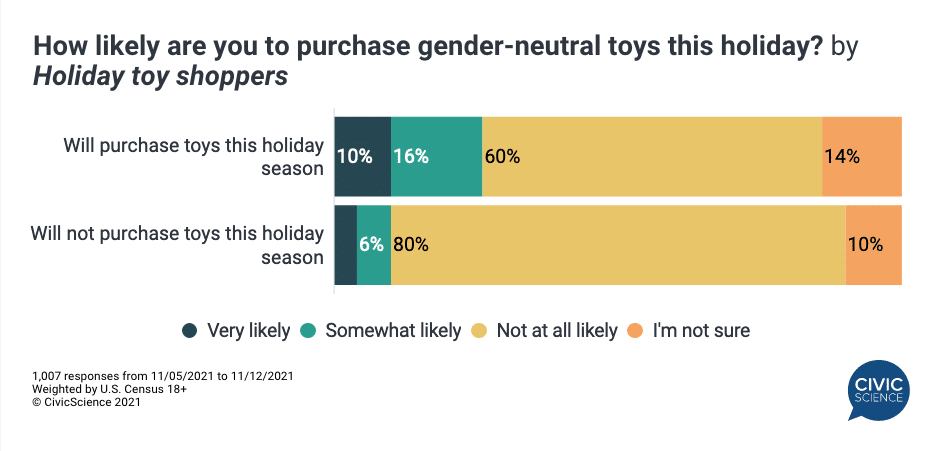
The people putting men in women’s sports, boys in girls’ locker rooms, and the Grinch in Christmas are also pushing “gender”-neutral toys. But if they’re dreaming of woke Yuletide gift-giving, they may be disappointed with a new survey finding that most shoppers aren’t neutral on “gender”-neutral toys — they’re wholly uninterested in them.
Polling 2,458 American adults, research entity CivicScience finds that just 15 percent are at all interested in buying what are properly known as “sex-neutral” toys (words have “gender”; people exhibit the biological distinction called “sex”).
Breaking it down further, 74 percent are “not at all likely” to purchase sexually confused toys; 12 percent are confused about whether they’d buy sexually confused toys, saying “I’m not sure”; nine percent are “somewhat likely”; and only six percent are “very likely.”
The numbers for sexually confused toys improve when considering only likely Christmas-season toy buyers, but still aren’t encouraging for the androgyny crew, with the “not at all likely” figure dropping to 60 percent and the “very likely” one rising to just 10 (chart below).

Yet even this is deceptive, as not all people buying sex-neutral toys do so for ideological reasons. After all, sex-neutrality “applied to toys is a broad concept, spanning the development of toys focused on removing gender bias and stereotypes, such as LEGO or the rebranded Potato Head, to repositioning how toys are sold in stores or online,” CivicScience (CS) relates. “For example, you can stroll down Target’s dedicated gender-neutral toy aisle, possibly without even realizing it.”
What’s more, some plaything-category items are naturally “sex neutral,” examples being bicycles, sleds, games, puzzles, and educational toys. In other words, many people have always bought such toys as just a matter of course. This helps explain CS’s claim that it’s unlikely sex-neutral toys “are just a passing fad.”
As for their becoming status quo, however, only 66 percent of CS’s respondents thought this would happen anytime soon; 23 percent think “many people will buy them,” and 11 percent suppose that “almost everyone will buy them.”
Of course, the 11 percent will be right if government pseudo-elites have their way. California recently enacted a law stating that large retailers must have sex-neutral sections for items such as toys and toothbrushes because they’re worried about, cue the drum roll, dreaded sex stereotyping.
As for CS, it concludes, “While the Gen Pop is not very warm to the idea of ‘gender-neutral toys,’ consumer choices may be trending in that general direction. LEGO’s popularity alone as a gift item this year is suggestive of that.”
Of course, Legos’ popularity may have as much to do with the COVID situation keeping kids at home as anything else. Moreover, how sex neutral are Legos, anyway?
Note that the company’s market research found years ago that 90 percent of Legos were bought for, and played with by, boys. This percentage has changed somewhat, claims Lego, though the company won’t disclose the new numbers. But here’s the rest of the story.
Aiming to widen its market, Lego conducted research and “found that girls and boys played with Legos differently from one another,” wrote the liberal Atlantic in 2016. “They consistently had distinct ideas about how to interact with the same toys they encountered — expectations that seemed to be drawn along gender lines in focus group after focus group. Lego had stumbled into a dynamic that’s as familiar as it is controversial; the idea that boys and girls, from a very young age, construct starkly divergent worlds for play.”
So Lego changed. “Thank Gaia!” exclaimed the feminists.
Yes, the company created the toy line “Lego Friends,” which pleased girls far and wide. You see, put simply, Lego Friends amounts to girly Legos, sort of the dollhouse principle applied to building blocks. Sets include the Heartlake City Play Hair Salon, the Baking Competition (video below), the Heartlake City Organic Café (you laughing yet?), the Heartlake City Bakery Building Toy, Mia’s Tree House, and Doggy Day Care.
Yeah, CS, sounds really sex-neutral!
Unsurprisingly, the Atlantic was upset about the sex stereotyping. Implicitly blaming societal conditioning, the magazine complained that even children “assume boys and girls are different in deep, fundamental ways. They assume that culturally specific traits, like wanting to sew or be a firefighter, are innate and biologically driven.”
Yes — and that’s called wisdom from the mouths of babes.
One could be tempted to say to these sex-neutrality types that the ‘80s called, and they want their “gender theory” back. In truth, this sameness-of-the-sexes fancy was debunked scientifically a couple of decades ago at least. Excellent works such as the Norwegian documentary The Gender Equality Paradox (which YouTube now has “age-restricted” — no bias there, of course — so I can’t embed it in this article) demonstrate well, and quite definitively, that the sexes are different womb to tomb.
So once again, the science-worshiping materialists deny science. More ironic still is that to a man — excuse me, to a non-binary, sentient (just barely) biped — these sex-neutrality types are evolutionists who believe the human is just another animal. Yet in our natural world, a lion rules his pride; a silverback gorilla (dominant mature male) runs his troop; different sex roles are the norm across species; and even chimpanzees, which the evolutionists love to say share 98.8 percent of our DNA, are male dominant. Despite this, they insist that man is perhaps alone, among all the sexually dimorphic “animals” the world over, in not having innately determined sex roles.
Here’s the kicker: While insisting sex roles are artificial and learned, they also insist homosexuality is natural and inborn.
Yeah, people who think like that should definitely be running the world.



